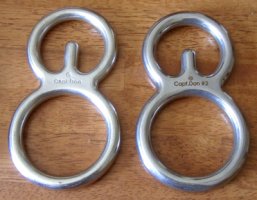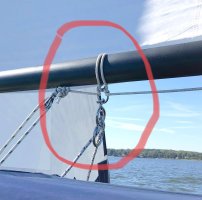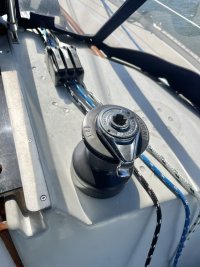You are using an out of date browser. It may not display this or other websites correctly.
You should upgrade or use an alternative browser.
You should upgrade or use an alternative browser.
Rigging a preventor on an E27
- Thread starter Bepi
- Start date
paul culver
Member III
If you search my posts for "boom brake" you'll find a system I use based on a piece of climbing hardware called an "eight". Its not a preventer, but it slows the boom crossing in an accidental jibe.
Last edited:
Any piece of line will work, just connect it to the boom midpoint more or less, and to something on the rail.
It works only to prevent the boom swinging without warning and knocking somebody on the head.
But dead downwind the course is entirely dependent on the helm person to keep from accidentally jibing, and there is really no getting away from that especially in shifty air. An accidental jibe should not happen and shows lack of attention. . The prevention solution is easy--just alter course a bit so the wind is not exactly behind us. In casual sailing that's usually no problem. When racing DDW, the helmsman is 100 percent alert and constantly looking behind him for surprise shifts.
In my opinion any accidental jibe is worth a crew meeting and discussion, and to be treated (gently) as the preventable error it is.
In heavy air, a preventer is a mixed blessing and sometimes not a blessing at all. If the boat broaches and jibes, the boom does not come slamming over -- it is stopped by the preventer. But now the boat is lying on its side on the other tack in 25 knots with the boom stuck up in the air and the mainsail backwinded under high tension on the preventer line, which becomes itself the first problem to deal with. Whereas if the boom jibes, well, that woke you up at least.
Rigging a temp preventer is a good idea, especially if kids are present on deck in casual family sailing. But like seat belts in a car, they are never supposed to come into use.
It works only to prevent the boom swinging without warning and knocking somebody on the head.
But dead downwind the course is entirely dependent on the helm person to keep from accidentally jibing, and there is really no getting away from that especially in shifty air. An accidental jibe should not happen and shows lack of attention. . The prevention solution is easy--just alter course a bit so the wind is not exactly behind us. In casual sailing that's usually no problem. When racing DDW, the helmsman is 100 percent alert and constantly looking behind him for surprise shifts.
In my opinion any accidental jibe is worth a crew meeting and discussion, and to be treated (gently) as the preventable error it is.
In heavy air, a preventer is a mixed blessing and sometimes not a blessing at all. If the boat broaches and jibes, the boom does not come slamming over -- it is stopped by the preventer. But now the boat is lying on its side on the other tack in 25 knots with the boom stuck up in the air and the mainsail backwinded under high tension on the preventer line, which becomes itself the first problem to deal with. Whereas if the boom jibes, well, that woke you up at least.
Rigging a temp preventer is a good idea, especially if kids are present on deck in casual family sailing. But like seat belts in a car, they are never supposed to come into use.
Bepi
E27 Roxanne
So far I have been lucky. I had hopes of finding a method that requires less attention, but so it goes. More practice is the answer.Any piece of line will work, just connect it to the boom midpoint more or less, and to something on the rail.
It works only to prevent the boom swinging without warning and knocking somebody on the head.
But dead downwind the course is entirely dependent on the helm person to keep from accidentally jibing, and there is really no getting away from that especially in shifty air. An accidental jibe should not happen and shows lack of attention. . The prevention solution is easy--just alter course a bit so the wind is not exactly behind us. In casual sailing that's usually no problem. When racing DDW, the helmsman is 100 percent alert and constantly looking behind him for surprise shifts.
In my opinion any accidental jibe is worth a crew meeting and discussion, and to be treated (gently) as the preventable error it is.
In heavy air, a preventer is a mixed blessing and sometimes not a blessing at all. If the boat broaches and jibes, the boom does not come slamming over -- it is stopped by the preventer. But now the boat is lying on its side on the other tack in 25 knots with the boom stuck up in the air and the mainsail backwinded under high tension on the preventer line, which becomes itself the first problem to deal with. Whereas if the boom jibes, well, that woke you up at least.
Rigging a temp preventer is a good idea, especially if kids are present on deck in casual family sailing. But like seat belts in a car, they are never supposed to come into use.
Did you go wing on wing when you slept on your Hawaii trip? Is a wind vane or auto helm enough to keep from jibing?
Bolo
Contributing Partner
In the recent past I used a Capt. Dan boom break which I connected to a ring that tied off forward to one of the fittings connecting the main sheet to the boom and another line leading after to the back end of the boom. Another line is connected to a port mid-cleat, through the boom break, through a snatch block on the starboard side then back to the cleat just aft of the jib sheet winch. Tightening that line adds more resistance to the line that goes through the break so that when you do jibe, if you have the tension just right (depending on the wind speed) then the boom will slowly swing to the new leeward. Sounds great right! Well, not really. You have to have that tension set just right for things to work well and that takes practice otherwise know as trial and error. The reason I put the Capt. Dan boom break on the boat in the first place was because my “first mate” almost had her head taken off in an accidental jibe when she was standing on the cockpit seat, a place where she shouldn’t have been when sailing downwind in a blow and I was taken by surprise by a sudden wind change. I also didn’t like the way the rigging took a shock even in a controlled jibe.
But recently I also added line clutches and a larger self tailing two speed winch (the old one was non-self tailing and undersized) which now makes it much easier to crank the main sheet in to near center, even in a blow, jibe and then let the main sheet out. “But Bob”, you might ask, “You can still have an accidental jibe?” Yes, that’s true but I don’t usually like to sail wing on wing unless the wind speeds are low and then I may attach a preventer, using part of the same set up as the boom break but instead attaching to the ring that was holding the boom break and then running that line back to the cockpit via the snatch block. Then I can pull the boom over for the safety of the cockpit. It’s important to do when you have non-sailors aboard who don‘t realize what can happen to that boom in a jibe. (They don’t even know what a jibe is!) When I need to sail in a direction towards downwind I almost always sail on something close to a broad reach (where an accidental jibe is highly unlikely) and then jibe to port and starboard while on my way because I thinks it can be faster and in the summer sailing on a run can get very hot especially during an August day on the Chesapeake Bay.
So I’ll probably be retiring my Captain Dan boom break to the spare parts bin because it’s just not needed anymore.

Capt. Dan Boom Break

Capt. Dan Boom Break on the boom. Line on left goes to the port mid-cleat. Line going right leads to snatch block on starboard side and then back to cockpit. I’m “retiring” this setup after improvements to main sheet controls.

Bigger winch (old one was a Barient 10 single speed and non-tailing) and rope clutches make line handling from the cockpit much easier. Yes, the “dimples” from the old holes in the cabin top are still there cause I haven’t gotten around to fixing the gel coat yet.
But recently I also added line clutches and a larger self tailing two speed winch (the old one was non-self tailing and undersized) which now makes it much easier to crank the main sheet in to near center, even in a blow, jibe and then let the main sheet out. “But Bob”, you might ask, “You can still have an accidental jibe?” Yes, that’s true but I don’t usually like to sail wing on wing unless the wind speeds are low and then I may attach a preventer, using part of the same set up as the boom break but instead attaching to the ring that was holding the boom break and then running that line back to the cockpit via the snatch block. Then I can pull the boom over for the safety of the cockpit. It’s important to do when you have non-sailors aboard who don‘t realize what can happen to that boom in a jibe. (They don’t even know what a jibe is!) When I need to sail in a direction towards downwind I almost always sail on something close to a broad reach (where an accidental jibe is highly unlikely) and then jibe to port and starboard while on my way because I thinks it can be faster and in the summer sailing on a run can get very hot especially during an August day on the Chesapeake Bay.
So I’ll probably be retiring my Captain Dan boom break to the spare parts bin because it’s just not needed anymore.

Capt. Dan Boom Break

Capt. Dan Boom Break on the boom. Line on left goes to the port mid-cleat. Line going right leads to snatch block on starboard side and then back to cockpit. I’m “retiring” this setup after improvements to main sheet controls.

Bigger winch (old one was a Barient 10 single speed and non-tailing) and rope clutches make line handling from the cockpit much easier. Yes, the “dimples” from the old holes in the cabin top are still there cause I haven’t gotten around to fixing the gel coat yet.
Dave G.
1984 E30+ Ludington, MI
Makes my brain tired just reading that ! Closer to broad reach with deliberate gybe's is the much more pleasing answer for me too. Generally more boat speed, more stability, & the autopilot is much happier !.In the recent past I used a Capt. Dan boom break which I connected to a ring that tied off forward to one of the fittings connecting the main sheet to the boom and another line leading after to the back end of the boom. Another line is connected to a port mid-cleat, through the boom break, through a snatch block on the starboard side then back to the cleat just aft of the jib sheet winch. Tightening that line adds more resistance to the line that goes through the break so that when you do jibe, if you have the tension just right (depending on the wind speed)
wing on wing when you slept...?
Yes, for a boat like ours wing and wing is most of the way to Hawaii, at least from latitude 34. A wind vane can handle it while you sleep.
The 32-3 broached periodically in heavy conditions, just a matter of squirting down 8-foot seas in squalls with no one at the helm. The 38, being steadier, not so much.
I learned to shorten sail at night, and quit looking for record mileage days and instead for prudence, comfort and why I was there at all.
Yes, for a boat like ours wing and wing is most of the way to Hawaii, at least from latitude 34. A wind vane can handle it while you sleep.
The 32-3 broached periodically in heavy conditions, just a matter of squirting down 8-foot seas in squalls with no one at the helm. The 38, being steadier, not so much.
I learned to shorten sail at night, and quit looking for record mileage days and instead for prudence, comfort and why I was there at all.
Bolo
Contributing Partner
Yes, of course Christian, how could I have forgotten that you sailed to Hawaii from LA wing on wing a lot of the time. Interesting that you broached a couple of times. Did that ever happen while you were below sleeping? It would have been a rude awakening I’m sure! Yes, David G, sorry about the ”wordy” explanation on rigging the Capt Dan boom break. I was going to draw up a diagram to explain it better but what’s the point? I’ll be removing it from the boat anyway. Also you’re correct and I forgot to mention, closer to a broad reach results in more stability and makes the auto pilot happier. That is especially true with the Chesapeake Bay’s shallowness which with the right wind and tide produces a short swell frequency making for a very uncomfortable ride. In those conditions wing on wing causes Ericsons to roll quite a bit, where I had to literally hang on to something, although I’ve seen that happen also to boats with full keels too but not as severe as Ericsons.
